26 Feb Level 1: Nearly 1 million data points show what it REALLY takes to lose fat, get healthy, and change your body.
Exclusive body transformation research: We analyzed a year’s worth of data from 1,000 nutrition coaching clients to find out how much effort it really takes to make meaningful change—to your body, your health, and even how you feel about yourself. These findings could shift the way you think about weight loss and health improvement forever. And most important, help you (or your clients) more easily achieve the sustainable results everyone wants.
++++
There is no perfect person.
(No matter how awesome you are.)
Yet when many of us contemplate a health plan, weight loss program, or other lifestyle change, we start with the expectation that we need to be perfect.
But how could you be?
You have stress, and feelings, and previous habits, and maybe a job or school or kids or a pet, and days when you feel like crap. Plus, Netflix.
If perfection is required, then most of us might as well not even bother.
But what if changing your body isn’t a pass/fail scenario?
What if almost any effort—no matter how imperfect—could result in real, measurable progress?
Turns out, that’s not just a nice idea: It’s the truth.
Changing your body doesn’t require 100% consistency.
We’ve got the data to prove it.
Our team just finished crunching an insane amount of data from our nutrition coaching program where clients give us daily feedback.
- 12 months
- 1,000 clients
- Nearly 1 MILLION data points
All to better understand how much effort it takes to make meaningful change.
Now, if you’re not familiar with our year-long coaching program for both men and women, here’s a snapshot of how it works: Clients check in every day and tell us whether or not they completed a workout (or other activity) and did “their habits.”
Habits are daily health practices—such as eating lean protein at each meal or consuming 5 servings of fruits and vegetables—that we give them every two weeks. These habits accumulate, and by the the end of the year, they’re incorporating about 25 in total. (Spoiler alert: This is how you change!)
They also regularly report their body measurements and answer progress surveys, where they tell us other important stuff, like how they’re feeling.
So, we looked at changes in our client’s bodies combined with how often they said they did their habits and workouts.
We focused on those who said losing weight was their top priority, and looked at how much weight (or body girth) they actually lost after a year.
And we asked:
How consistent do you have to be in order to make “good progress”?
What we discovered didn’t surprise us, but it might surprise you.
It could even inspire you to embrace your “imperfect” self, and make the (surprisingly small) changes that can transform your body and your life.
Surprise #1: Just putting in some effort—no matter how small—changes things.
What happens when people do their habits and workouts less than half of the time?
You might assume their efforts are a total waste.
You’d be wrong.
People lost weight anyway.
Clients who are less than 50% consistent—but stay in the program for the full year—wind up losing between 5-6% of their total body weight.
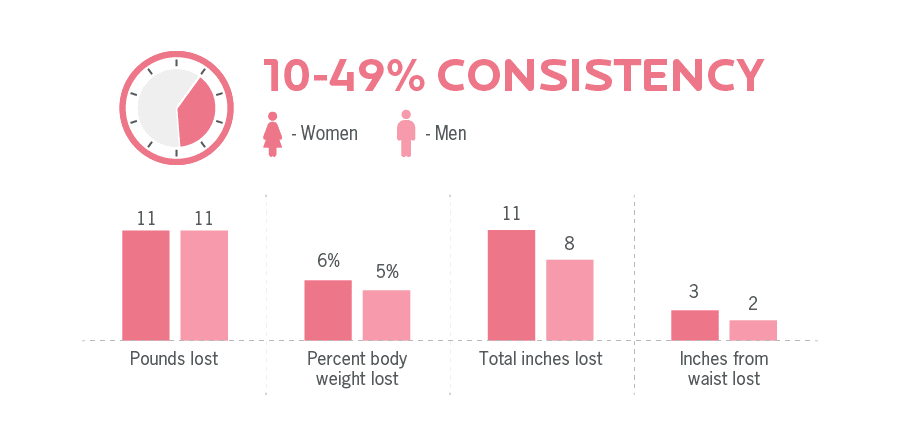
Now, 5-6% loss of body weight might not sound like much, but you can see the average weight loss for both men and women was 11 pounds. That’s sustained weight loss—something that stays with you, and something you can build on.
And people did it by kinda-sorta practicing some small healthy habits, not following rigid meal plans or extreme diets that eliminate entire food groups.
People also got healthier.
That’s because research suggests a 5-6% decrease in body weight can lead to:
- better cardiovascular health
- decreased cancer and diabetes risk
- better sleep (with less apnea)
- better mood
- less inflammation
- better immunity; and maybe best of all…
- a zestier sex drive.
What does less-than-half consistency look like?
Let’s think about how this might play out in real life.
Maybe you eat a lot of fast food and packaged snacks. And your assigned habit is “eat more whole foods.”
If you eat four times per day—say, three meals and one snack—that means you’re eating 28 times a week. If just 12 of those meals or snacks were made of fresh, minimally processed foods, you’d be about 40% consistent.
This would be the equivalent of swapping out a fast food lunch for a green salad topped with lean protein every day, along with having a piece of fruit for a snack most days, but then changing nothing else.
And by the way, although we’re using 40% as our example here, there were certainly people who were 30%, 20%, and even just 10% consistent that achieved similar results, on average. Almost any consistent effort, applied over time, seems to be enough to move you forward.
Here’s another way to look at it.
Let’s say you want to eat more fruits and vegetables (another assigned habit in the PN Coaching program). If 100% consistency means you eat 5 servings of fruits and vegetables each day, that would be 35 servings per week.
If you were aiming for 40% consistency, you’d need to consume just 14 servings of produce in one week. Or an average of 2 servings per day.
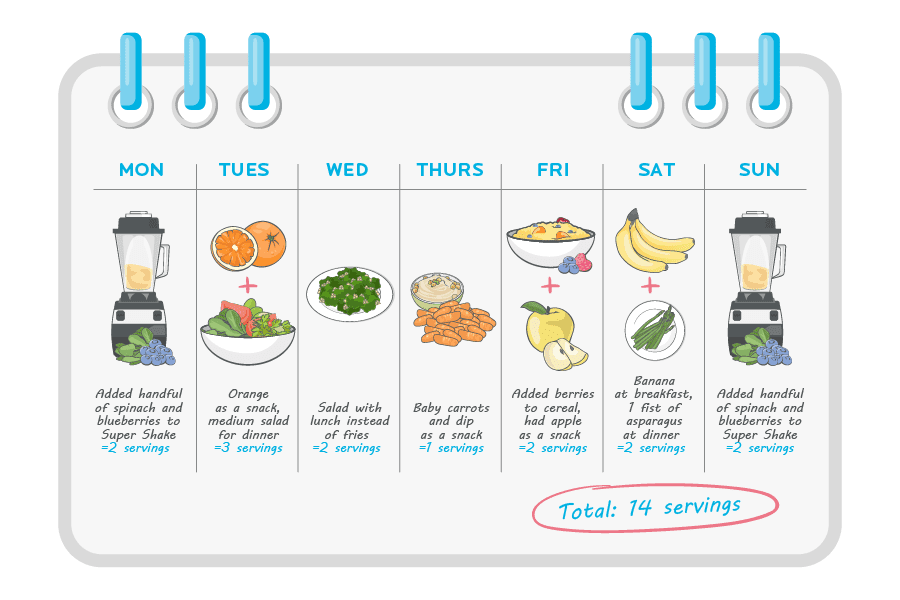
What about workouts?
If doing something active every day means you’re being 100% consistent, then doing something active 40% of the time would require 2.8 activities. In real life, that might translate to two intense workouts, plus two long walks per week.
But remember, these are just examples.
Your goals will be relative to your starting point.
For instance, if you haven’t exercised in a year, 100% consistency might mean being active just three days a week. And as a result, 40% consistency would be just 1.2 weekly workouts.
If all of this sounds easy, you’re right.
It’s about learning to accept that better is better, and even a little effort can translate into real weight loss and health benefits.
Surprise #2: Showing up between 50-79% of the time actually makes a big difference.
50-79%: The beautiful balance between half-assing and getting results.
Now, here’s the magic zone between “not too difficult” and “making real progress”: somewhere between 50 and 79% consistent.
Our data showed no statistical difference between groups that hit this level of consistency, whether it was 50-59%, 60-69%, or 70-79%.
Wrap your head around that.
Not only do you not need to be “perfect” to get results, you don’t even need to be “pretty good.”
For example, by doing their habit practice and workouts at least half the time:
- Men lost an average of 6 pounds more, compared to the guys who did their habits and workouts less.
- Women dropped just one more pound (they weighed less to begin with), but they lost 4 more total inches.
A “habits at least half the time” approach also burned through belly fat, as both men and women shrunk their waists, moving them out of the high risk categories (35 inches of circumference for women; 40 inches for men) for heart disease, diabetes, and other metabolic health problems.
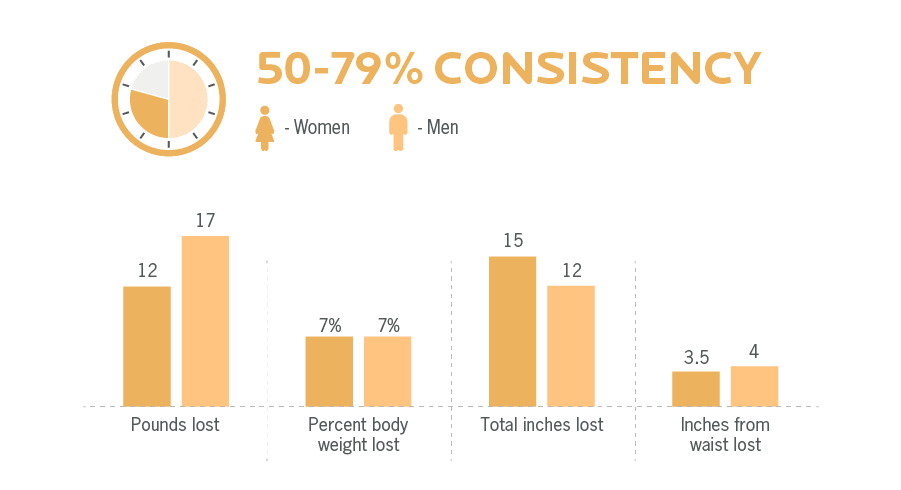
Surprise #3: Being at least 50% consistent with your health and lifestyle improvements might be easier than you think.
You don’t need to be a superstar.
With some small, manageable changes (especially if you get help and support from a coach), you—yes, even you, with the children and covered in dog hair and rushing to soccer practice—can be pretty darn consistent.
Most of our clients end up in the 50-79% consistent group (even though they often feel like they’re “not doing enough”).
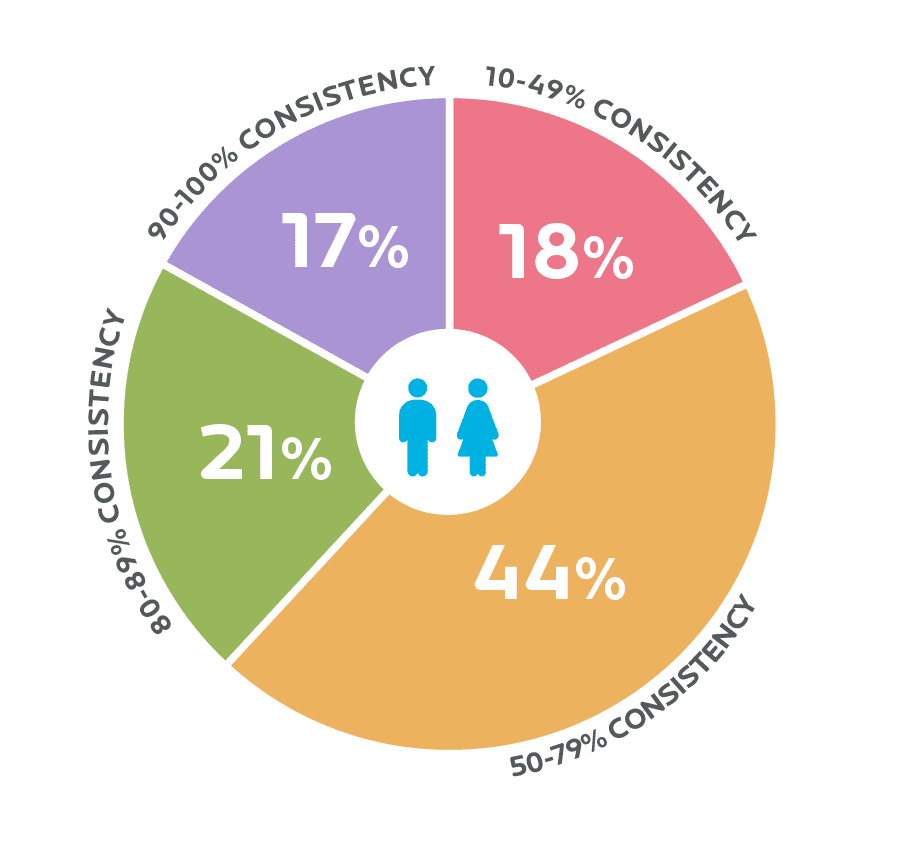
Once again, think about what this might mean in the context of your life.
Maybe dinners at your house are nuts. The family is scrambling to get homework done, or get to extra-curricular activities; the teenager or toddler is complaining about the food; someone brought home greasy takeout, and it’s a whirlwind.
Right now, eating “whole foods” mindfully and slowly with the right portion size is so not happening for you.
But… what if you could figure out how to organize your breakfasts and lunches a little better—without a lot of life disruption?
If you nail a healthy breakfast and lunch, plus the occasional snack, you could hit your mark of eating nutritious foods at 17 out of 28 weekly meals. And boom… 60%.
Or perhaps you want to control your portions. At Precision Nutrition, one of our core habits is called “eating to 80% full.” This helps you naturally reduce your intake by learning to tune into hunger and fullness cues, and getting used to stopping when you’re satisfied, but not stuffed.
If your goal were eat to 80% full at breakfast, lunch, and dinner every day (21 meals per week), you’d be 60% consistent if you did that at only 13 meals.
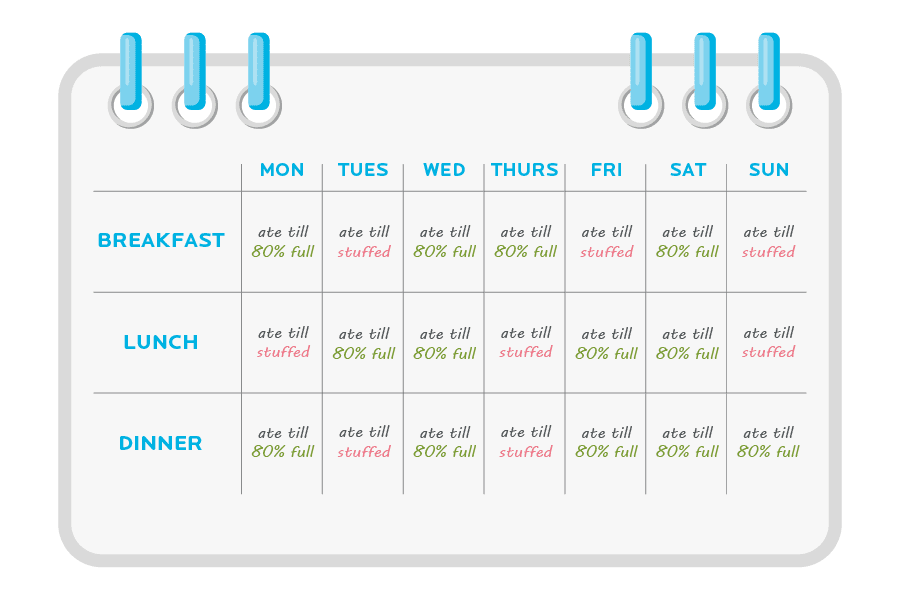
Another example: Let’s say you love wine but want to drink less.
And let’s say that “100% consistent” is never drinking. (Wait… stop screaming. Stick with us here.)
If you normally have three glasses of wine each night, and you cut that down to one, you still get a daily Chardonnay, and you’ve knocked out two-thirds of your regular habit.
Perfect? No, but definitely better. And better is the goal.
In all these cases, you’ve got lots of wiggle room. And as the data shows, you’ll still come out ahead.
Surprise #4. Even super-dramatic changes don’t require 100% consistency.
As you may know, some PN clients achieve incredible body transformations.
Of course, if you’re after big changes, you’ll have to be more consistent, and make more tradeoffs or adjustments to your lifestyle.
But even so, you still don’t have to be perfect.
Our data show that being 80%-89% consistent with your nutrition and lifestyle habits can result in significant—and, more importantly, sustained—losses in body weight and waist size.
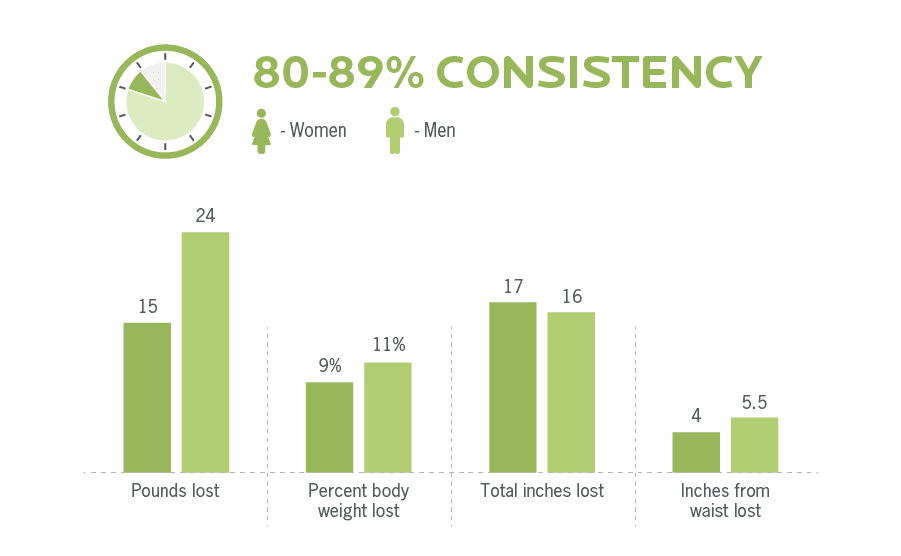
How does this level of consistency take shape in real life?
Let’s go back to our practice of eating nutritious meals, made of mostly whole, fresh, minimally processed foods with lots of good stuff in them. (What we call “PN-friendly.”)
If you eat 4 meals a day, again, that’s 28 meals a week. Achieving 80% consistency means about 22-23 meals are “PN-friendly.” And that means 5-6 meals might be “less optimal.”
Now suppose you’re trying to cut out desserts.
If you’re used to eating dessert every evening, then 80% consistent would mean skipping dessert about 5-6 times over the course of the week.
That’s a big change, but it doesn’t mean total dessert deprivation. You’d still have 1-2 desserts to enjoy each week, and the rest of the week is highly consistent. Double win!
Surprise #5: People’s actual circumstances didn’t determine what they were able to do.
You’d think having particular demands on you would make it harder to stick to your habits.
That’s why we ask our clients about things like their work schedule, whether they have kids, whether they travel a lot, and/or how much stress they feel.
In fact, there was no correlation between how much stress people felt at home or at work, or how well they said they were coping with that stress, and the results they got.
In other words, no matter what a dumpster fire of flaming stress some people’s lives were… if they were able to figure out how to take small, meaningful actions day to day, they were able to be consistent anyway.
This often meant having creative solutions, like:
- Eating the same meal for breakfast and lunch, rather than prepping two separate ones.
- Getting meal or grocery delivery, if they could afford it.
- Enlisting older kids into shopping and meal prep help.
And so on.
It also meant knowing how to scale back a little—rather than completely shutting down—whenever things didn’t go as scheduled.
For example, imagine you sleep through your alarm, or drop a carton of eggs on the floor at breakfast. Suddenly, you have no time to get to the gym.
Instead of skipping your workout all together, you can turn a walk with the baby in the stroller or a trip to the playground into the “workout.” It may not have been what you planned, but you still got some exercise.
This is called adjusting the dial, and it helps you stay consistent, even when life gets messy.
You can apply this concept to not only your exercise habits (shown in the “dial” illustration below), but also to your eating and overall wellness habits. (Learn more about the “dial method”.)
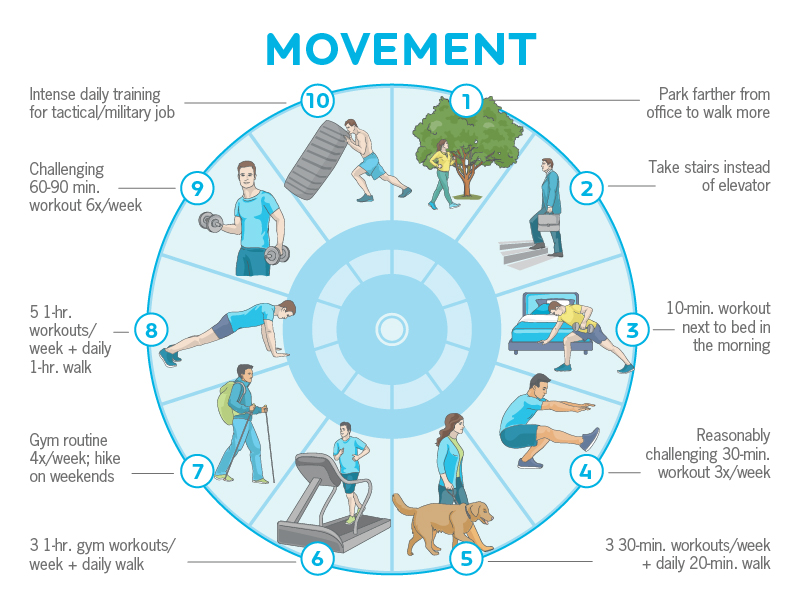
As you devise these work-arounds, your consistency is sure to improve, as will your results. In fact, some of our clients became so good at this they were able to achieve an astounding 90-100% consistency.
And again, their increased effort paid off, with more weight and inches lost.
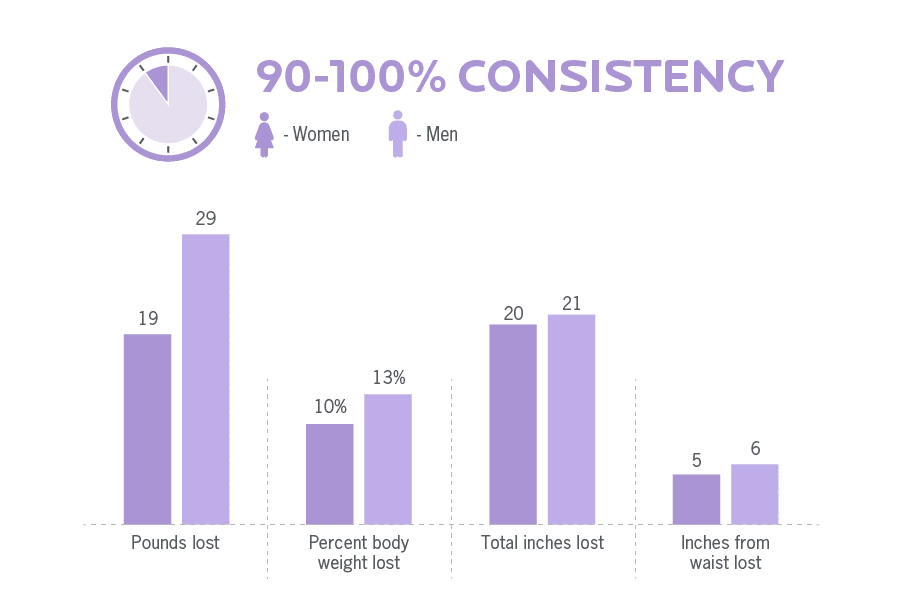
To be sure, this level of consistency isn’t doable for everyone. And that’s okay.
Not all of us desire to work this hard or live with all the tradeoffs it requires—or even care about such dramatic physique changes. (For more, see The Cost of Getting Lean.)
But even so, 17% of our clients were able to hit this mark. And they did it by adding one habit at a time and building from there. Just like everyone else.
Now… have a look at the results from all groups together, and take note. It provides a nice visual of how improvements in consistency truly drive change. (Have we made our point yet?)
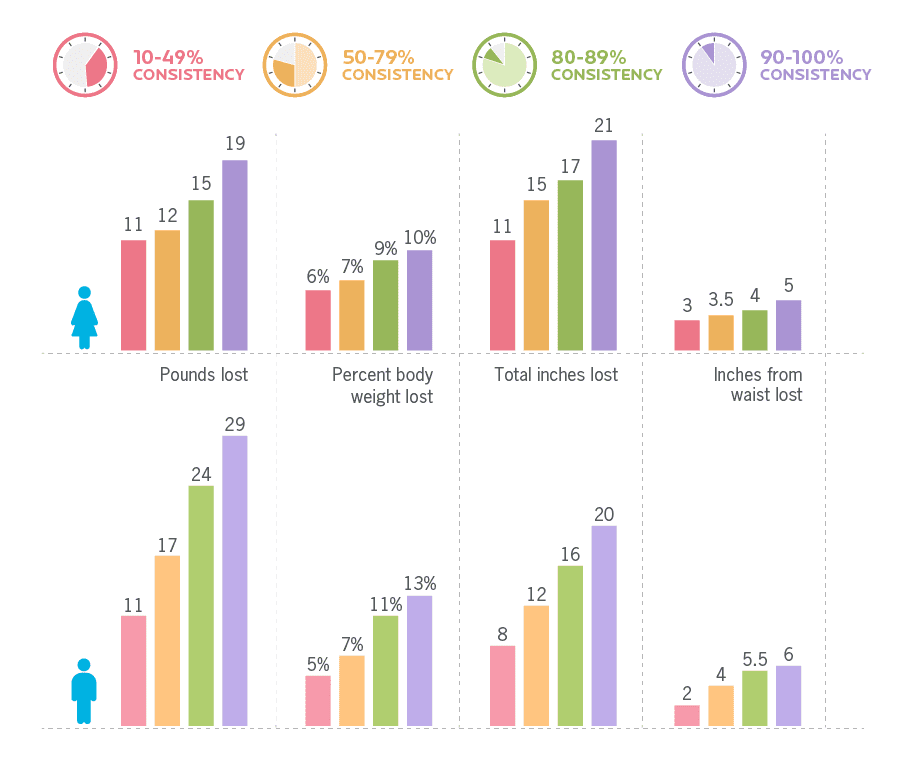
Surprise #6: Just making some effort—however inconsistent and imperfect—can make you feel better about how your body looks, feels and moves.
Consistency creates confidence.
Many forms of progress are invisible to the bathroom scale.
That’s why we include a 13-question “resilience index” in our PN Coaching program. We ask clients to tell us how they feel, by indicating how strongly they agree or disagree with statements like:
- I’m the person I want to be.
- I lead a meaningful and purposeful life.
- I feel good about how my body looks.
- I feel healthy and physically thriving.
- I feel confident in my ability to take charge of my life.
What we found:
The more consistent people were, the better they felt about life in general.
In part, this happens because people feel good about the changes they see in their bodies, such as less pain, more fitness, and the ability to do more movements, more easily.
But it also happens because people are acting on their own behalf.
We gain positive energy, confidence, and resilience after and because we act, not the other way around.
Even a small boost in confidence might mean:
- You walk into a gym for the first time.
- You try a new exercise.
- You say hi to that attractive person.
- You dress better.
- You take on a physical challenge, like a race.
- You consider a more active vacation, like a hiking trip.
- You finally wear that bathing suit, or take off your shirt, at the beach.
- You ask for what you need and want, or say no to what you don’t want.
- You take care better care of you.
And each action you take only creates more action.
No perfection required.
You can still become, at last, the healthy, thriving, confident person you’ve wanted to be—just by putting in whatever effort you’ve got.
Whether that’s 40%, 60%, or 80%, your best really is good enough.
If you’re a coach, or you want to be…
Learning how to coach clients, patients, friends, or family members through healthy eating and lifestyle changes—in a way that helps them adopt simple but effective habits they can sustain—is both an art and a science.
If you’d like to learn more about both, consider the Precision Nutrition Level 1 Certification. The next group kicks off shortly.
What’s it all about?
The Precision Nutrition Level 1 Certification is the world’s most respected nutrition education program. It gives you the knowledge, systems, and tools you need to really understand how food influences a person’s health and fitness. Plus the ability to turn that knowledge into a thriving coaching practice.
Developed over 15 years, and proven with over 100,000 clients and patients, the Level 1 curriculum stands alone as the authority on the science of nutrition and the art of coaching.
Whether you’re already mid-career, or just starting out, the Level 1 Certification is your springboard to a deeper understanding of nutrition, the authority to coach it, and the ability to turn what you know into results.
[Of course, if you’re already a student or graduate of the Level 1 Certification, check out our Level 2 Certification Master Class. It’s an exclusive, year-long mentorship designed for elite professionals looking to master the art of coaching and be part of the top 1% of health and fitness coaches in the world.]
Interested? Add your name to the presale list. You’ll save up to 33% and secure your spot 24 hours before everyone else.
We’ll be opening up spots in our next Precision Nutrition Level 1 Certification on Wednesday, April 3rd, 2019.
If you want to find out more, we’ve set up the following presale list, which gives you two advantages.
- Pay less than everyone else. We like to reward people who are eager to boost their credentials and are ready to commit to getting the education they need. So we’re offering a discount of up to 33% off the general price when you sign up for the presale list.
- Sign up 24 hours before the general public and increase your chances of getting a spot. We only open the certification program twice per year. Due to high demand, spots in the program are limited and have historically sold out in a matter of hours. But when you sign up for the presale list, we’ll give you the opportunity to register a full 24 hours before anyone else.
If you’re ready for a deeper understanding of nutrition, the authority to coach it, and the ability to turn what you know into results… this is your chance to see what the world’s top professional nutrition coaching system can do for you.
The post Level 1: Nearly 1 million data points show what it REALLY takes to lose fat, get healthy, and change your body. appeared first on Precision Nutrition.
Powered by WPeMatico



Sorry, the comment form is closed at this time.